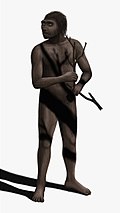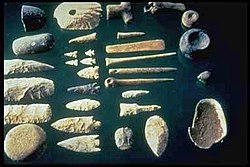
The following outline is provided as an overview of and topical guide to prehistoric technology.
Contents
- Nature of prehistoric technology
- Old World prehistoric technology
- Stone Age technology in the Old World
- Prehistoric Bronze Age technology in the Old World
- Prehistoric Iron Age technology in the Old World
- End of prehistory and the beginning of history
- Prehistoric technology of the Americas
- Lithic technology
- Archaic period technology
- Formative stage technology
- Prehistoric technologies by type
- Primitive skills
- Prehistoric tools
- Gallery
- See also
- Sites
- References
- Further reading
- External links
Prehistoric technology – technology that predates recorded history. History is the study of the past using written records; it is also the record itself. Anything prior to the first written accounts of history is prehistoric (meaning "before history"), including earlier technologies. About 2.5 million years before writing was developed, technology began with the earliest hominids who used stone tools, which they may have used to start fires, hunt, cut food, and bury their dead.



